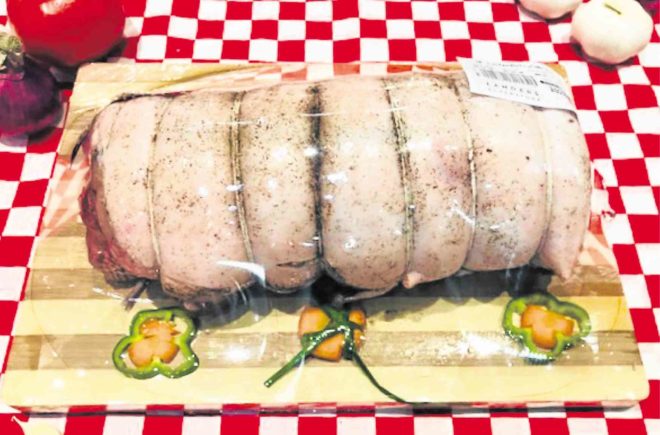
The day Landers Arcovia opened was a field trip for me and my friends.
We went aisle by aisle, meticulously going through their merchandise, busy discerning which items we really needed as opposed to what we wanted.
The highlight for me was to see so many interesting, proudly Philippine-made products.
‘Chicharon’
My first discovery was Landers’ chicharon from the cart of Pam Yatco Ang, a Xavier co-parent.
The pork rinds were visually appetizing and once sampled, a delight. Mildly seasoned, it had a deep flavor, with a subtle yet lingering spice on the finish. The bite, gentle yet crunchy.
Available in two variants: Regular, made purely from pork skins from the back loin; and Special, made from the back loin, with a bit of back fat and small portion of meat.
I encountered a shelf stacked with Frabelle Salted Egg Fish Skins, of which there were two kinds: regular and spicy.
I grabbed one and opened mine while waiting at the checkout counter. I passed it around and we all agreed that it was well done.
A tad sweet, chili-spiced, and perfumed with curry leaves.
The Norwegian salmon skins were evenly coated in a light salted egg batter, which is why it was crisp throughout and on the mouth crumbled beautifully.
According to Frabelle’s R&D corporate chef Reyson Lukban Imson, the famous Singapore fish skins are the favorite snack of Frabelle’s matriarch, Bella Tiu Laurel.
Having the raw materials readily available, it made sense to create their own rendition of it.
The salted egg fish skins are made using machines to ensure the even coating of the salted egg mix. It is then packed and flushed with food-grade nitrogen to prolong shelf life. No preservatives are added to the product.
Congratulations to my dear friend, Frabelle’s Kiko Laurel, for a well-executed product.
‘Lechon de leche’
I am happy to announce that raw, dressed, ready-to-roast lechon de leche are now available at Landers!
The 1.5 to 2-month-old suckling pigs (that range in weight from 4 to 5 kg) are of the native variety and are raised in the islands of Simara Corcuera and Banton, Romblon. Some are sourced from Marinduque, too.
For your pleasure, I am sharing a simple lechon recipe with you.
1 Landers lechon de leche
1/3 c coarse sea salt, for rubbing inside the pig and on the skin
Stuffing:
250 g young banana leaves, coarsely chopped
3 c young sampaloc leaves
10 pandan leaves, knotted
6 lemongrass stalks, tied and bruised
¼ c roasted peppercorns, lightly crushed
1 tbsp vegetable oil
Rinse the piglet in running water. Pour hot water into the cavity. Drain. Pat entire piglet dry.
Rub cavity with 1/3 c sea salt.
Stuff cavity and sew to secure cavity.
Rub 2 tbsp sea salt on the skin until salt is absorbed.
Put pig on a rack over a baking tray. Brush ears with oil and wrap with foil.
Roast pig in the oven at 350°F for 1½ hours.
Increase heat to 375°F and continue to roast until skin is golden brown and crisp. Let rest 15 minutes before serving.
Yet another great find, is the marinated, ready-to-cook rolled lechon belly.
I cut the Landers pork belly lechon in half. I roasted one and fried the other.
To roast:
Preheat oven to 350°F.
Put meat in a roasting pan and add half an inch of water on the baking pan.
Cover with foil and bake for 2 hours or until fork tender.
Remove meat from baking pan and transfer to a rack.
Increase oven temperature to 450-475°F and cook the liempo uncovered until golden and crisp.
The roasted meat was mildly seasoned and aromatic from the lemongrass. Serve the belly with your favorite lechon sauce.
The other portion I slow-cooked in a pot of water (just enough to submerge the meat) and deep-fried it. That turned out well, too.
Tips for fried lechon belly:
Do not remove the pork from the cooking liquid and leave it to cool before frying. Pork from the liquid to the hot oil results in moist belly meat on the inside and crunchy skin on the outside.
Make sure the oil is hot before frying and the quantity sufficient enough to submerge the liempo.
Be very careful as oil will splatter. Have the cover of your cooking vessel ready for your safety.
Organic ‘muscovado’
With this heat, I was thrilled to use raw brown organic muscovado for my sago’t gulaman.
The sugar was so pristine in taste. It’s excellent, in fact.
Here’s how I did it:
I made red gulaman (follow package instructions).
I bought large cooked sago that I washed in running water, submerged in boiling water and drained.
I made syrup by bringing 2 cups water and 3 cups muscovado to a boil. I left the syrup to simmer for 15 minutes and then left it to cool. To that I added 1 tsp vanilla extract. Take note that when I make local drinks, I opt for local extract brands such as Orchid or Mrs. Brown (I find these in Farmers Market) to bring back tastes and fond memories of festive local flavors from my childhood.
Spoon sago and gulaman into a glass. Add crushed ice and syrup.
My new cooking class schedule is now available. For inquiries, text 09175543700, 09082372346.














































